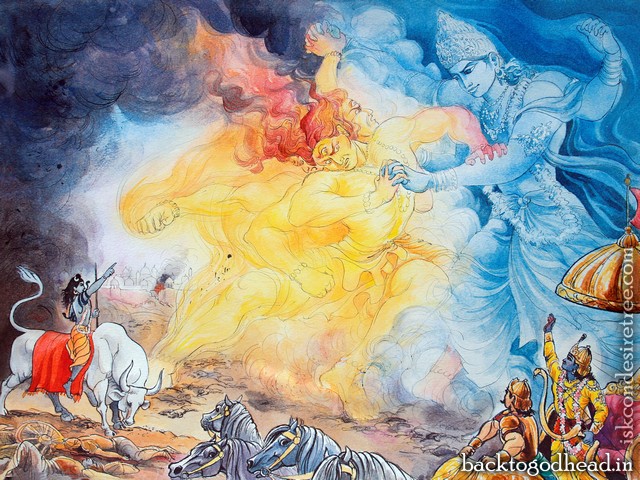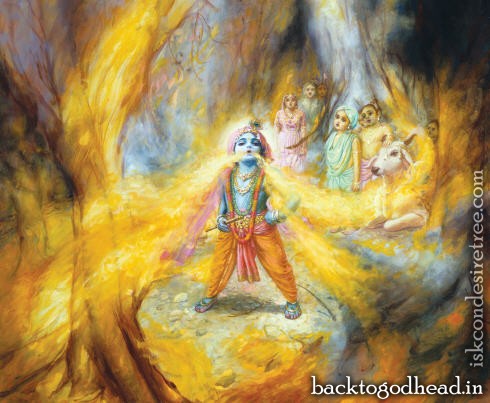The Adriatic Sea laps at my feet on a Croatian beach. The last rays of the sun are long gone. and the sky is the depest blue. Across the bay is an oil refinery, and the flame at the top of a chimney, invisible during the day, has become aprominent. I watch the flame dance and marvel at how fire captures one's attention.
It's not surprising. I muse, that this little bit of Krishna's energy is so alluring. The name Krishna means all-attractive. Krishna is a person and from him come all energies which are identical to him. Fire, therefore, is also Krishna. By thinking about the qualities of fire we can remember Krishna the Supreme Spirit. Because some aspect of fire is constantly with us, it thus becomes easy to enter into deep spiritual consciousnes even while in apparently mundane situations.
First we will meditate on the heat of fire then its light and then its beauty. Thinking about the beauty of fire naturally brings us focus on Krishna’s form. Finally we will contemplate His pastimes with fire.
Heat
After air, most people name food and water as our most basic physiological needs. But we can live weeks or months without food, and often more than a week without water. The most basic bodily need after air is correct temperature.

We experience life-giving heat in two ways from the sun. One is directly on our skin and the other indirectly through digestion, which releases the sun’s energy transformed into food through photosynthesis. For warmblooded creatures like us humans, eighty percent of the food we eat is used to produce internal heat. Yet we forget how this heat outside and inside our bodies sustains us. Heat is, after all, invisible. To a conditioned soul, Krishna is also invisible. He sustains us, is inside our heart and all around us, yet we do not see Him, and we forget our dependence upon Him. An ordinary person might cease to give without some gratitude or even acknowledgement. But Krishna gives even to those who entirely forget Him.
The way heat sustains us yet is invisible brings to mind the verse in the Bhagavad-gita where Krishna says that He is like a string upon which pearls rest. We know the string is there because the pearls hang in an orderly way, but the string itself hides in the pearls’ core.
Though similar to a thread in this way, Krishna is not fragile like a thread. Think of the power of heat, which comes from Him. A slight difference in temperature, and instead of life there is death or severe injury. Those who handle fire must do so with care and respect. We might huddle close to a bonfire on chilly days, but we don’t get too close. Similarly, unless we are full of pure love of God, we serve Krishna according to the rules of worship and service to avoid getting burned by offenses.
Mitch Kahn, an experienced firefighter, writes, “A fire is like a living thing a living engine of destruction. And each blaze has its own personality. There’s a sound and smell to a wildfire that you never forget. Burning brush and searing wind roaring like a jet engine. The acrid odor of scorched earth.” Indeed, the destructive power of heat brings to mind scriptural descriptions of periodic universal dissolution. At that time, the Lord, being unhappy at the conditioned souls’ continuously working against their own self-interest, envelopes the cosmos in heat more intense than numerous suns.
We err if we think in terms of heat as being good or bad. Krishna is all good, and even the destructive burning of heat purifies and cleanses. Farmers sometimes burn a field to remove weeds and their seeds, the ashes fertilizing the soil. Scientists and medical doctors depend on the sanitizing action of heat’s destructive force. Similarly, Krishna tells us in the Bhagavad-gita that transcendental knowledge of the soul and God burns up all ignorance and suffering. Achieving loving union with Krishna also removes the potency of all the material desires that bind us to karma and rebirth, just as seeds fried in high heat lose all power of germination.
Seeds are also burned when a devotee takes vows of commitment to serve the Lord. The initiation ceremony involves throwing grains into a sacrificial fire. The fire is understood as Krishna’s tongue: He eats the grains and thus purifies the giver. The pleasing heat from the Lord’s tongue of sacrifice reminds us that warmth is associated with life itself and that the Lord is the Supreme living being, the source of all life. Warmth is also associated with love we speak of a warm embrace or a cold glance. Krishna’s warmth is one manifestation of His encompassing love for all living beings. Whenever we feel the heat of the sun, fire, or the furnaces in our buildings, we can feel both the life and the love of Krishna.
Life and love are often associated with food. Heat transforms both the texture and the flavor of raw food, making hard vegetables swim in their own juices when flames lick the bottom of a pot. Similarly, Krishna releases a flow of affection even from dry philosophers and melts even steel-like hearts into the flowing butter of love. Just as heat reveals a variety of flavors otherwise hidden in uncooked food, when a soul serves Krishna diverse and intense emotions of ecstasy manifest themselves. The chemical fire in our body, with which Krishna directly identifies Himself in the Gita, distills food to its essence in order to nourish the body’s organs and systems. In doing so, it separates value from waste.
According to the Ayurveda, the ultimate product of the heat of digestion is vitality and strength. Similarly, in the final stages of purification through serving Krishna, the soul is brought to its pure state of spiritual power, where all unwanted things, such as identification with the material body and mind, are finished.
Cooking with too much heat will burn the outside of food while leaving the inside raw. Cooking at just the right temperature, with patience, gives us food that is tasty throughout. Similarly, under expert guidance we need to apply with care the process of connecting with Krishna through chanting, hearing, and serving. Impatient bhakti-yogis may take up extreme practices that leave them discouraged, with their heart barely touched. But those who have enthusiasm, confidence, and patience find that bhakti-yoga gradually transforms their thoughts and feelings, melting their hearts.
Heat cooks our food by exciting molecules that crash into each other. Heat can destroy a food’s structures and create new ones. Heat also creates air currents upon which birds travel the skies. Heat from the sun pulls water vapor into clouds, thus starting the cycle that both purifies the water and distributes it around the world. Heat’s effect of causing other things to move and flow reminds us that contact with Krishna is stimulating. Even inanimate objects react to Him rocks melt at the sound of His flute. Krishna stirs the heart and mind of all who connect with Him.
Light
Just as warmth is closely associated with both life and love, so is light. We speak of how people’s eyes light up when they meet someone they love. A person full of life is often described as having a sunny disposition. Light thus reminds us that Krishna is the life of all that lives and the best friend of all.

Lighted candles, colored light bulbs, and fireworks often play a role when friends, families, and communities gather for holidays, festivities, and celebrations. Upon seeing such lights, we can meditate on how every day in the spiritual world is a festival. Krishna, the reservoir of pleasure, delights in eternal varieties of transcendent parties.
Whether we are visiting others for a party or entering our own home, light welcomes us. When the lights are on, we know that someone is home and awaiting our arrival. Greeting others with light is as ancient as humankind. Thus we offer a flame to the deity in the traditional arati ceremony performed in Krishna temples. As one famous prayer says, the devotee offers Krishna arati with the lamplight of love. Krishna is also welcoming us with His light, shining forth in all splendor to invite us back home.
Krishna’s invitation illumines our hearts so that we can clearly perceive both truth and illusion and thus choose to reunite with Him. Indeed, gaining such knowledge is often termed “enlightenment.” In the most simplistic sense, we gain most of even our mundane knowledge through vision, which requires light. Whenever we see light, we can remember how Krishna is the source of knowledge on every level, both spiritual and material.
The scriptures often compare knowledge to sunlight, which is also sometimes equated with Krishna’s weapon Sudarsana, which means “auspicious vision.” Sunlight, or Sudarsana, is the eye of the Lord. To function, our eyes need light entering them, but Krishna’s eyes emit light. We sometimes communicate with only our eyes, and Sudarsana is called “the master of speech,” because when the light of knowledge fills us, truth comes from our mouth.
Light is the source of nourishment not only for the words and mind, but also for the body. At the bottom of the food chain are plants that use photosynthesis to transform sunlight into sugars and starches. Through this process, transformed light is the food that nourishes the bodies of nearly every living being on earth. If we meditate on how the food we eat is the sun’s energy and how Krishna says that He is directly the light of the sun, we can easily feel a connection with Him with every bite.
Besides the hot light of the sun, there is soothing moonlight, which cools and refreshes us after a day of work. Coming to Krishna’s shelter is often compared to taking advantage of moonlight for relief and peace. Also, the moon inspires romantic love among ordinary people, but it can remind a spiritual practitioner of Krishna’s pure love dance with the saintly milkmaids.
Fire and Krishna’s Beauty
Krishna says He is the splendor of fire. Fire is beautiful, full of majesty. Sunshine sparkling on the ripples of a lake on a clear day, an outdoor bonfire on a chilly night, clusters of stars in the heavens, glittering chandeliers, neon signs, blinking lights on Christmas trees, tiny flames on cotton wicks in little clay pots floating on the Ganges fire is certainly splendid. Not only is fire itself beautiful, but the beauty of anything exists only because the light of some fire illumines the object. Without light the word beauty has no meaning, as there would be no ability to behold it. Without fire there are no colors. If all beauty and brilliance depend on fire, we can hardly imagine the beauty of the Supreme Lord, the source of all fire, warmth, and illumination. How gorgeously brilliant His form must be!
Indeed, sacred writings describe Krishna’s spiritual, eternal, everyouthful form as effulgent and beautiful beyond material understanding. His cheeks are compared to sapphire mirrors upon which His swinging earrings are reflected. Krishna’s clothes glow like liquid gold, and His toenails are so brilliant that when He places His soft feet on jeweled footstools, the multicolored jewels appear to be made out of crystal.
Krishna Drinks Fire
To show us the nature and activities of His eternal world, Krishna appeared in His dazzling form on this planet about five thousand years ago. In two of His divine pastimes as a young cowherd, He swallowed huge forest fires that threatened His animals and friends. In the first instance, most of the inhabitants of Vrndavana village were resting near the Yamuna River after Krishna had vanquished a serpent polluting the river and the surrounding area. As the flames from a sudden fire threatened to burn everyone, Krishna drank the fire.

Another day, Krishna and His friends had taken their herds of cows, goats, and buffalo across the Yamuna to a large banyan tree. Busy playing there, the boys did not notice that the animals had wandered away looking for succulent grass. When they realized that they had been negligent and failed to protect their families’ source of livelihood, they looked for the animals in vain.
Finally the boys found and followed the trail of eaten grass and trampled vegetation. Meanwhile the animals had wandered far away and had encountered a forest fire. Fleeing, they became stuck in sugar cane. The sharp leaves and strong cane made it hard for them to extract themselves, and they cried in fear. Krishna called each animal by name, and they called back to Him. The boys then traced the animals to the cane and rescued them.
But as they walked back to the banyan tree, great winds whipped the fire close, surrounding them. The boys looked to Krishna and begged Him to save them, His intimate friends. Through a loving look, Krishna told them not to fear and to close their eyes. He had been thirsting for fire (perhaps as some people like spicy food), so He grabbed the huge fire and drank it like a cooling beverage. Gradually the boys and animals opened their eyes to find, much to their surprise, that not only was the fire gone, but they were back at their starting place near the tree, grateful to be close to the river, where after the heat of the fire they could drink to their full satisfaction.
Krishna has other pastimes related to fire, such as when He summons His weapon of utter cold to counteract Shiva’s demon of personified flame in the battle with Banasura. And when Krishna displays His universal form in the Bhagavad-gita, fire comes from His mouth.
As I finish writing this meditation, the sun is setting here in Southern California. The rooms are starting to look dull, although the sun still overwhelms the electric light. Light also streams from my computer monitor onto my face, and I feel the warmth of my body, generated from the meal I ate. A candle burns on the altar. Some form of fire is with us always. When we make an effort to find Krishna in His energy of fire, we delight Him with our interest in our relationship with Him, and He reciprocates by revealing Himself more and more.
“O Supreme Lord, You are actually the air, the earth, fire, sky, and water. You are the objects of sense perception, the life airs, the five senses, the mind, consciousness, and false ego. Indeed, You are everything, subtle and gross. The material elements and anything expressed, either by the words or by the mind, are nothing but You.” (Srimad-Bhagavatam 7.9.48)
Urmila Devi Dasi, a BTG associate editor, has a Ph.D. in educational leadership from the University of North Carolina in Chapel Hill, USA. She is working on international curriculum projects for primary and secondary education in ISKCON.
